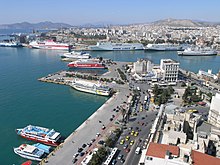Piraeus
![]()
This article describes the Greek city. For the prefectural district of the same name, see Piraeus (prefectural district), and for the regional district, see Piraeus (regional district).
f9f10f8
Piraeus (Modern Greek Πειραιάς Pireas [pirɛˈas] (m. sg.); Ancient Greek Πειραιεύς Peiraieús) is a municipality in Attica, a major industrial centre in Greece and the third largest port on the Mediterranean Sea. The municipality proper had a population of 163,910 in 2011; together with the other municipalities of the Piraeus Regional Municipality, the figure was 448,997; the entire Athens-Piraeus metropolitan area has a population of about 3.8 million, according to Eurostat, although other estimates put the population at least five million due to the lack of mandatory registration. Piraeus is the historic port of the Greek capital Athens and the southern terminus of the important transport links crossing the country from Thessaloniki and Patras. Piraeus has the largest passenger port in Europe, handling around 17.6 million passengers (16.5 million by ferry and 1.1 million by cruise ship) annually (as of 2019). With a throughput of 5.65 million TEU (as of 2019), the port of Piraeus is the fourth largest in Europe in container traffic and the one with the largest container throughput in the Mediterranean.
Etymology
Already ancient authors derived the name Peiraieus (Πειραιεύς) from the word peraieús περαιεύς 'ferryman', to ancient Greek πειραιόω peiraióō 'to bring across', this to Greek péra πέρα 'opposite, beyond' (cf. Pera, Peraia). It probably referred to the ferry services between Piraeus and Phaleron. The port of Corinth also bore the name Peiraiós Πειραιός, another word for 'ferryman'. In German the name with the meaning as port of Athens is also with article: der Piräus.
History
Piraeus (Peiraieus) is actually the name of the mountainous peninsula, eight kilometers southwest of Athens, with the hill Mounychia (today Kastella), up to 86½ meters high, which supported a castle since the 6th century BC, and three deeply cut round harbor basins (Piraeus, Zea and Mounychia), which Themistocles designated as the port of Athens since 493 BC and initially surrounded with walls. In 461-456 BC the Long Walls were built between Piraeus and Athens.
In the Periclean period, Hippodamos of Miletus laid out the city complex with streets intersecting at right angles, and the harbours were expanded and provided with porticoes and ship houses. Destroyed at the end of the Peloponnesian War, Piraeus soon flourished anew as a trading port. In 394 BC, the walls destroyed by the Spartans were also rebuilt.
In the years 347-323 B.C. the arsenal of Philon was built, which Sulla burned down in 86 B.C. with the rest of the harbour facilities.
After the relocation of the port, ancient Piraeus, as the port city of Athens, was divided into the sub-ports of Kantharos, Zea and Mounychia. Kantharos was the commercial port of Piraeus, while Zea and Mounychia were reserved for the military. Zea was the larger of the two naval ports.
In the Middle Ages, the port was known by the Italian name Porto Leone, after the ancient lion sculpture now standing in front of the Venice Arsenal (a copy is now back in Piraeus). The corresponding Turkish name was Aslan Limani. The smaller ports of Zea and Mounychia are nowadays also known as Passalimani (port of the Pasha) and Tourkolimano (Turkish port) or Mikrolimano (small port) respectively.

Port of Piraeus

On the shore remains of the old wall
Search within the encyclopedia